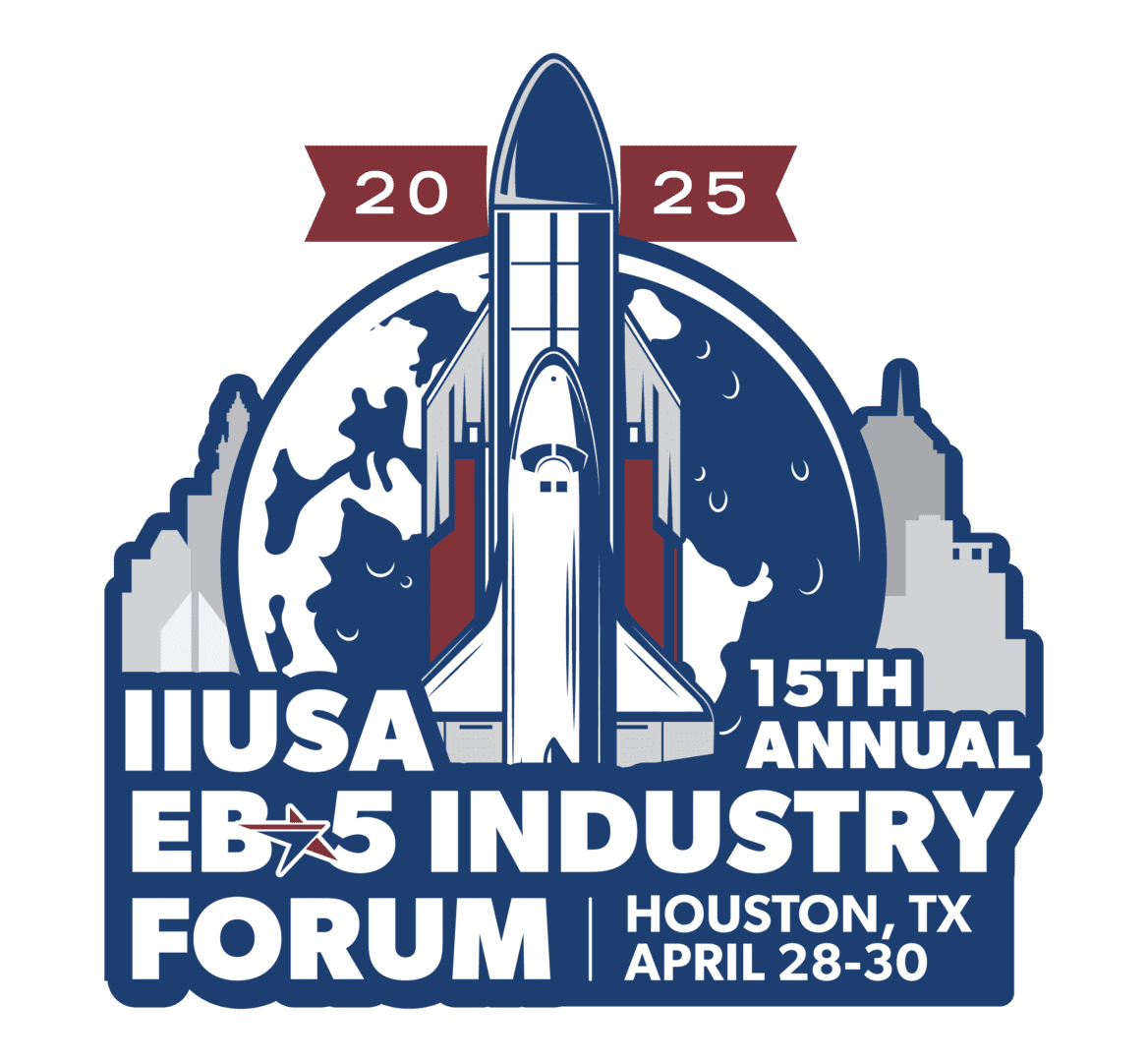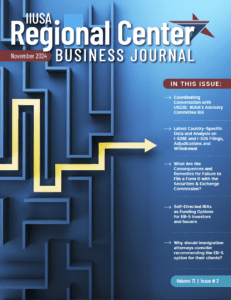
Stephen Yale-Loehr
Two Key Senators Introduce Bill to Extend and Improve EB-5 Program
By Stephen Yale-Loehr, President Emeritus, IIUSA; Of Counsel, Miller Mayer LLP
On June 3, 2015, Senators Patrick Leahy of Vermont and Chuck Grassley of Iowa introduced a bill in the U.S. Senate to reauthorize and improve the regional center part of the employment- based fifth preference (EB-5) green card program. The 79-page bill (S. 1501) would extend the EB-5 program for five years and make several changes to the program. [1] This article summarizes key provisions of the bill.
EB-5 Overview
Congress enacted the EB-5 program in 1990. [2] At the time, the program granted lawful permanent resident status only to immigrant investors who directly invested in and managed job-creating commercial enterprises. Since 1992, with enactment of the regional center pilot program, potential immigrant investors can also invest through EB-5 regional centers. [3] In 2012, Congress reauthorized the regional center program through September 30, 2015. [4] Today, there are over 800 approved EB-5 regional centers. [5]
As background, a potential EB-5 recipient must first file an I-526 petition with the U.S. Citizenship and Immigration Services (USCIS) requesting classification in the EB-5 category. Upon USCIS’s approval and a background check, the investor becomes a conditional resident for two years. [6] At the end of that two-year period the applicant must file an I-829 petition with USCIS. The investor must prove that he or she has invested the required capital and that the investment created or will create ten full-time jobs for U.S. workers.
Key Features of S. 1501
S.1501, called the American Job Creation and Investment Promotion Reform Act, would make significant changes to the EB-5 program, including:
EB-5 Regional Center Program Extension
Section 2 of S. 1501 would reauthorize the EB-5 regional center program for five years, until September 30, 2020. The bill would also repeal section 610 of the original 1992 appropriations law that set up the regional center program and move it to INA § 203(b)(5)(E).
Minimum Investment Amount
Currently, EB-5 investors invest $500,000 if their investment is in a targeted employment area (TEA) and $1 million otherwise. S. 1501 would increase the minimum investment amount to
$800,000 for investments in a TEA and $1.2 million for investments not in a TEA. The Department of Homeland Security (DHS) could increase that amount by regulation. In addition, the minimum investment amount would automatically increase, based on the consumer price index, every five years.
Revised Definition of a Targeted Employment Area
The current statute defines a targeted employment area as a rural area or an area that has experienced high unemployment of at least 150 percent of the national average. [7] The statute defines a rural area as an area not within a metropolitan statistical area (MSA) or the outer boundary of any city or town having a population of 20,000 or more. [8] Each state notifies USCIS which state agency will apply these guidelines, and determines TEAs for that state.
S. 1501 would revise the statutory definition of a TEA to include a rural area, a closed military base, or an area consisting of a single census tract that has 150 percent of the national average unemployment rate. For TEAs in an MSA, at least fifty percent of a project’s job creation would have to be within that MSA to be counted. If the TEA is outside of an MSA, at least fifty percent of the jobs would have to be created within the county in which the TEA is located. If not, the total number of jobs would be reduced until the fifty percent threshold is met.
Senators Leahy and Grassley, who are both from rural states, clearly would like to see more EB- 5 projects in rural areas. Some of the bill’s language on this issue, however, is ambiguous. For example, it is unclear whether a project in an area that is in two census tracts–one that has an unemployment rate more than 1.5 times the national average, the other that doesn’t–would qualify. It is also hard to know how USCIS or a project developer could determine that fifty percent of indirect jobs would be created in the relevant county.
Job Creation Requirements (Indirect Jobs)
The regional center program does not require that the immigrant investor’s enterprise itself directly employ 10 U.S. workers. Instead, a regional center project can count both direct and indirect jobs. [9]
In response to concerns about how to count indirect jobs, S. 1501 would stipulate that indirect jobs could count for no more than ninety percent of the all the jobs counted for EB-5 purposes. The bill is unclear whether the job-creating enterprise would have to have direct employees. If so, this could hurt infrastructure and other types of EB-5 projects that typically rely only on indirect job creation.
Currently, jobs created by domestic investors can be allocated to EB-5 investors. S. 1501 would change that. A maximum of thirty percent of the total jobs created through non-EB-5 investment would be allowed, even if the non-EB-5 investment represents more than thirty percent of the project’s funding. Assume, for example, that U.S. investors invest $8 million toward a new hotel, and EB-5 investors invest $2 million. Assume also that the new hotel creates a total of 100 new direct and indirect jobs. Under current law, EB-5 investors could claim all 100 jobs. Under S. 1501, only thirty percent of the jobs created by the U.S. investors could be allocated to EB-5 investors.
Regional Center Oversight and Compliance
S. 1501 would add major reporting and compliance requirements for both regional centers and enterprises associated with regional centers. This section would require regional centers to certify annually that they are complying with various requirements. This section would basically codify and expand on the current I-924A reporting requirements. Regional center principals and others associated with a regional center would not be eligible to participate in the EB-5 program if they have previous securities violations or various civil or criminal judgments for fraud, deceit, securities violations, or have been subject to discipline as an attorney.
DHS could sanction a regional center for various violations. Sanctions could include civil penalties of up to ten percent of the total EB-5 capital raise, a temporary suspension, a permanent bar from program participation, or regional center termination.
Regional centers would also have to certify that they and all parties associated with the regional center are complying with state and U.S. securities laws. DHS would have “unreviewable discretion” to terminate a regional center or a commercial enterprise associated with a regional for violations or if the regional center or an associated commercial enterprise has engaged in fraud, misrepresentation, criminal misuse, or poses a threat to national security.
Everyone directly or indirectly involved in running or managing a regional center would have to be a U.S. citizen or permanent resident. No foreign government entities could be directly or indirectly involved with the ownership or administration of a regional center.
Source of Funds Changes
An EB-5 investor must prove the lawfulness of the money they are investing in the United States. [10] S. 1501 would expand the “source of funds” review that USCIS conducts. For example, the regulations currently require that investors provide at least five years of tax returns. [11] S. 1501 would expand that to seven years. USCIS currently does not require investors to prove the lawful source of any administrative fees they pay in addition to their capital contribution. The bill would require administrative fees and costs to be lawfully obtained.
S. 1501 would limit the use of gifts as the source of EB-5 investments. Gifted funds could only be used for EB-5 investments if gifted by a spouse, parent, child, sibling, or grandparent.
S. 1501 would also limit the use of loans as the source of EB-5 investments. Capital based on loans would have to be secured by the investor’s personal assets. This would codify a recent interpretation by USCIS that limits certain third party loans to EB-5 investors. [12] Moreover, any loans would have to be obtained by a reputable bank or lending institution that is properly chartered or licensed under laws of the applicable state, territory, or country.
Concurrent Filing and Age-Outs
S. 1501 would allow concurrent filing of an I-526 petition and I-485 adjustment of status application if a visa number is immediately available. The bill would also amend INA § 245(k) to include EB-5 investors. This means that an EB-5 investor who has been out of status for less than 180 days would nevertheless be able to adjust status.
S. 1501 would help certain children of EB-5 investors. If a parent’s I-829 petition is terminated, the bill would allow a child to still be considered a child for EB-5 purposes if the child remains unmarried and the parent files a subsequent I-526 petition within one year after the original petition was terminated.
Other Provisions
S. 1501 would provide that if a regional center or new commercial enterprise is terminated, investors who have already obtained conditional residence would have 180 days to affiliate with a new regional center, invest in a new project in the same regional center, or make a new investment through a project affiliated with a different regional center. The two-year conditional residence program would start over.
If an EB-5 investor has sustained his investment for at least two years before being admitted to the United States, S. 1501 would allow the investor to file his or her I-829 petition at any time. They would not have to wait an additional two years after being admitted as a conditional resident. This would help EB-5 investors who make their investment but then are delayed in entering the United States because of processing delays of visa quota backlogs.
Conclusion
S. 1501 is significant because it is a bipartisan bill introduced by Senators Grassley and Leahy, who are the ranking members on the Senate Judiciary committee. No hearing date has been scheduled yet to discuss the bill.
A bill to make the EB-5 regional center program permanent (H.R. 616) was introduced in the House of Representatives in late January. That bill, which has 18 co-sponsors, would also make significant changes to the EB-5 program, such as eliminating the per-country cap for EB-5 and other employment-based green cards.
Finally, Rep. Darrell Issa and Rep. Zoe Lofgren are expected to introduce separate bills soon to extend and enhance the EB-5 program.
The EB-5 regional center program needs to be extended by September 30. If Congress fails to agree on improvements to the EB-5 program by that date, it is possible that Congress could simply extend the program for a short time without changes while it finalizes substantive changes. Stay tuned for an interesting summer and fall.
1. The full text of S. 1501 is at https://www.congress.gov/bill/114th-congress/senate- bill/1501?q=%7B%22search%22%3A%5B%22%5C%22s1501%5C%22%22%5D%7D.
2. Immigration Act of 1990, Pub. L. No. 101-649, 104 Stat. 4978.
3. Departments of Commerce, Justice, and State, the Judiciary and Related Agencies
4. Pub. L. No. 112-76, § 1, 126 Stat. 1325 (2012) (also removing the world “pilot” from the program name).
5. A list of all approved EB-5 regional centers is on the USCIS web site at http://www.uscis.gov/eb-5centers.
6. INA § 216A, 8 U.S.C. § 1186b; 8 C.F.R. § 216.6. See generally Charles Gordon, Stanley Mailman, Stephen Yale-Loehr & Ron Wada, Immigration Law and Procedure § 39.07 (2014).
7. INA § 203(b)(5)(B)(ii), 8 U.S.C. § 1153(b)(5)(B)(ii).
8. INA § 203(b)(5)(B)(iii), 8 U.S.C. § 1153(b)(5)(B)(iii).
9. 21st Century Department of Justice Appropriations Authorization Act, Pub. L. No. 107-273, § 11037(a)(3), 116 Stat. 1758 (2002).
10. 8 C.F.R. § 204.6(j)(3); see also Stephen Yale-Loehr, USCIS Explains How to Deal with EB-5 Source of Funds Issues, https://iiusa.org/government-affairs/uscis-government-affairs/uscis- explains-deal-eb5-source-funds-issues-stephen-yaleloehr/; Stephen Yale-Loehr & Christopher Repole, Show Me the Money: Proving Lawful Source of Funds for EB-5 Immigrant Investors, https://millermayer.box.com/s/xy9ugp21yf80ao1l1d0t.
11. 8 C.F.R. § 204.6(j)(3)(ii).
12. Lincoln Stone & Susan Pilcher, Investing Cash from Loan Proceeds: A New Interpretation of “Indebtedness,” https://iiusa.org/uncategorized/investing-cash-loan-proceeds-interpretation- indebtedness-lincoln-stone-susan-pilcher/.







